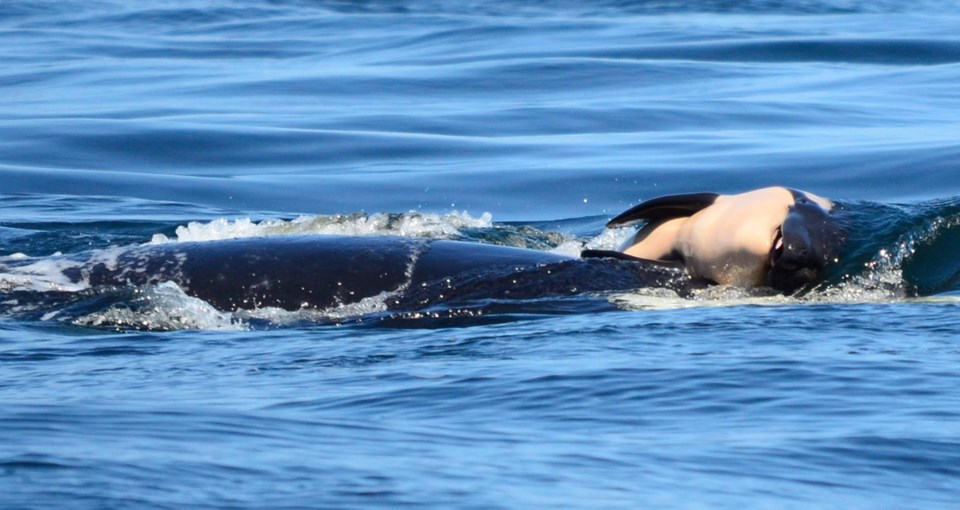A commentary by the author of The Killer Whale Who Changed the World and host of the Skaana podcast. Leiren-Young’s latest book, Orcas Everywhere, is being released in September.
A year ago, an orca broke our hearts. On July 24, 2018, Tahlequah, a 20-year-old orca, gave birth to a daughter. She entered the Salish Sea and joined a community known as the southern resident orcas who are only a few tragedies away from extinction.
Orcas have a sense humans don’t: echolocation. A human might have seen or heard that the baby orca was struggling. Tahlequah would have seen and heard much more than any of us could.
Echolocation allowed her to “see” how shallow her daughter’s breaths were, how weak her heart was beating. Tahlequah knew the exact moment the breathing stopped, the heart stopped, the hope died.
Instead of letting her daughter’s lifeless body slide beneath the waves, the mother orca caught her child.
Cetaceans around the world have been seen carrying their dead before … for a few days. After Tahlequah carried her daughter for four days, I called Ken Balcomb, who has devoted his life to studying this population since the 1970s. The founder of the Center for Whale Research told me the longest this behaviour had been observed was about a week.
Neither of us could imagine she would carry the body for more than a few more days. No one imagined she’d carry her daughter’s body for 17 days. No one imagined she’d carry her baby for more than 1,600 kilometres. Balcomb called this “a very tragic tour of grief.”
He believed Tahlequah was sending a message to us.
If you spend enough time around orcas you know that’s exactly the kind of thing orcas do. The message Balcomb heard: “this is what extinction looks like.”
I’ve read scientists argue that Tahlequah may have thought that if she held her daughter long enough, she’d take a breath. It was easier for these “experts” to pretend these intelligent beings don’t understand death than to accept that orcas grieve.
After Tahlequah shone a global spotlight on the plight of the southern residents, scientists in Canada and the United States launched an emergency effort to diagnose and save a dying three-year-old orca named Scarlet.
Balcomb and others had raised the alarm about Scarlet weeks earlier. Back then, an attempt to save her might have succeeded. But weeks earlier, the world wasn’t watching.
Without the world watching, it might have been impossible to convince the Lummi Nation, Canada’s Department of Fisheries and Oceans, the U.S. National Oceanic and Atmospheric Administration, the Whale Sanctuary Project, Balcomb’s Center For Whale Research, several other orca-related organizations and vets from the Vancouver Aquarium and SeaWorld to work together.
Tahlequah accomplished more in 17 days than all the advocates for the southern residents have in the 50-plus years they’ve been fighting for this population.
She convinced the world to care. Suddenly, watching these whales die without attempting to save them was unthinkable. She also taught people that this population needs Chinook salmon to survive.
In the United States, Washington Gov. Jay Inslee announced a plan to spend $1.1 billion on orca recovery. Although he reached that number by declaring that anything his government did that related to the ocean was all about the orcas, it’s hard not to be impressed by his decision to give the orcas such prominence.
But the U.S. presidential candidate currently isn’t doing anything to remove the dams in the Lower Snake River that are interfering with vital salmon runs.
In Canada, Justin Trudeau’s government earmarked more than $200 million to help the southern residents. Actions included creating sanctuary zones, increasing hatchery production of Chinook and more regulations dealing with underwater noise and pollutants.
But Team Trudeau bought and approved a pipeline, knowing it could doom this population. And Chinook fishing is inexplicably still allowed — even through several Chinook populations are listed as endangered and we could lose this keystone species even if orcas weren’t eating them.
A year after the death of Tahlequah’s daughter — who the Samish tribe named TiTahlequah (little Tahlequah) — stakeholders are back to arguing over solutions and finding reasons to delay them with redundant research — rather than doing everything possible to save these whales.
So far this summer, the southern residents have barely been seen in the Salish Sea. Large, healthy, wild Chinook have also barely been seen.
Scoter, a 28-year-old male from K Pod, and Princess Angeline, a 42-year-old matriarch of J-Pod, are missing and likely dead. There’s also a new daughter of J-Pod to celebrate, but the only hope for her, and the rest of this population, is if we remember, and honour, Tahlequah’s tour of grief.



